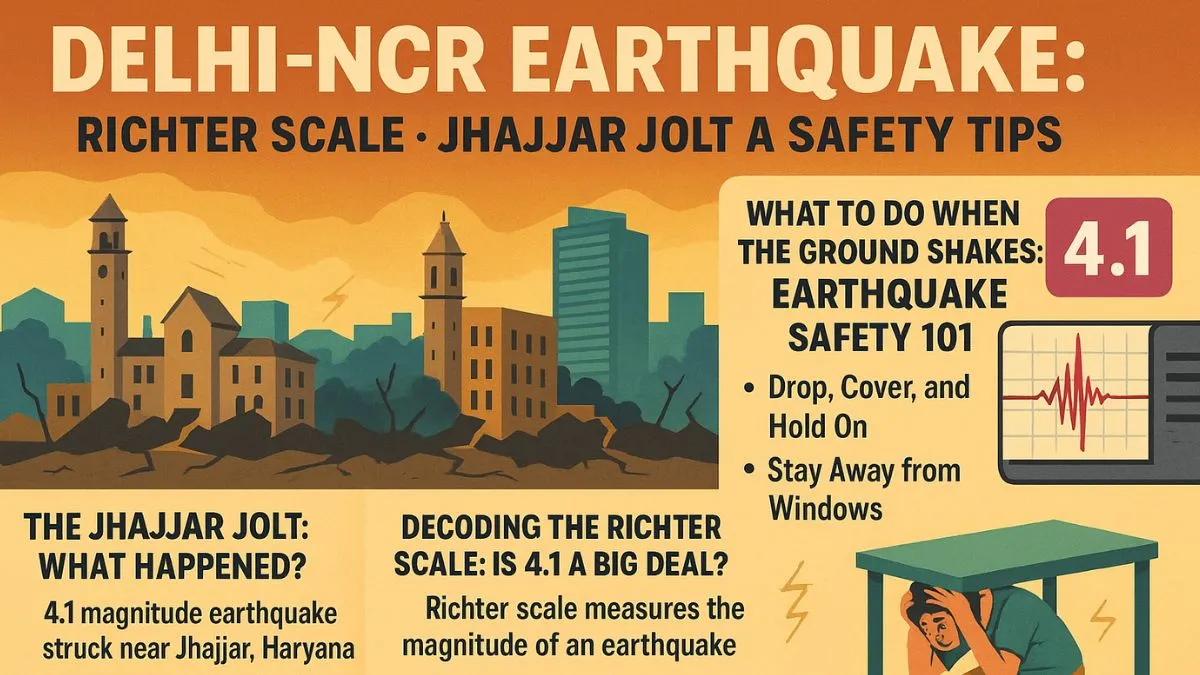Here’s the article:
Ever felt that sudden jolt, that little shake that makes you wonder, “Was that an earthquake?” If you live in Delhi or around, you might’ve felt exactly that recently! We’re talking about the earthquake that hit near Jhajjar, Haryana. It wasn’t massive, but enough to make things rattle and people take notice. Ever wondered how these things happen? What does that number on the Richter scale *really* mean? Well, stick around, because khabaritank is about to break it down for you in a way that’s easier than understanding why your mom says “no” to that extra scoop of ice cream.
In this article, we’ll look into what happened during the recent Delhi-NCR earthquake, what the Richter scale is all about, and what you should do if you ever feel the earth move. By the end, you’ll be an earthquake expert – well, almost! You’ll definitely know more than your friends, that’s for sure. And who knows, maybe you’ll even be able to impress your science teacher!
The Jhajjar Jolt: What Happened?
Okay, so picture this: You’re chilling at home, maybe watching TV or scrolling through your phone, when suddenly, things start to shake. Not like your little brother is jumping around, but a real, noticeable shake. That’s what happened to folks in Delhi and nearby areas. A 4.1 magnitude earthquake struck near Jhajjar, Haryana. Now, 4.1 might not sound like much, but it’s enough to give everyone a little scare and make them wonder what’s going on. Think of it like this: a 4.1 earthquake is like someone lightly shaking a soda can – you notice it, but it’s not going to explode.
Decoding the Richter Scale: Is 4.1 a Big Deal?
You’ve probably heard about the Richter scale whenever earthquakes are mentioned on the news. But what *is* it? Simply put, it’s a way to measure the size of an earthquake. Think of it as a thermometer, but instead of measuring temperature, it measures the energy released by an earthquake. The scale goes from 0 to, theoretically, infinity, but in reality, we rarely see anything above a 9. Now, here’s the thing: the Richter scale is logarithmic. That means each whole number jump is ten times bigger than the last! So, a 5.0 earthquake is ten times stronger than a 4.0. A 4.1 quake, like the one in Jhajjar, is considered a minor earthquake. It might rattle things and scare people, but it’s not likely to cause major damage. But hey, khabaritank believes its always better to be safe than sorry!
Earthquakes in Delhi-NCR: Why Does This Happen?
So, why do earthquakes happen in Delhi-NCR anyway? Well, India is located in a seismically active zone. This means the earth under our feet is constantly moving and shifting. Imagine it like a giant puzzle made of puzzle pieces. These puzzle pieces are called tectonic plates, and they’re always bumping into each other. When these plates get stuck and then suddenly slip, that’s when you get an earthquake. The Delhi-NCR region sits close to several fault lines, which are basically cracks in the earth’s crust. This makes the area more prone to earthquakes, even if they’re usually small ones.
What to Do When the Ground Shakes: Earthquake Safety 101
Okay, so you feel an earthquake. What do you do? First, don’t panic! Easier said than done, right? But panicking won’t help. Here’s the plan:
- Drop, Cover, and Hold On: Get under a sturdy table or desk, cover your head, and hold on tight. If there’s no table nearby, crouch down against an interior wall and protect your head.
- Stay Away from Windows: Windows can shatter during an earthquake, so steer clear.
- If You’re Outside: Find an open space away from buildings, trees, and power lines. Drop to the ground and stay there until the shaking stops.
- After the Shaking Stops: Check for injuries and damage. Be careful of falling debris. If you’re in a building, evacuate as soon as it’s safe to do so.
Earthquakes, even small ones, can be unsettling. But understanding what’s happening and knowing what to do can make a big difference. The recent tremor in Delhi-NCR, originating near Jhajjar, was a reminder that we live in an area prone to seismic activity. The Richter scale helps us understand the magnitude of these events, and knowing basic safety tips can keep you safe if the ground starts shaking. At khabaritank, we want you to be informed and prepared! So, the next time you feel a rumble, remember what you learned here, stay calm, and stay safe. After all, knowledge is power, and being prepared is even better!







